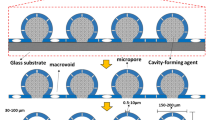The sorption capacity of binder polymer with respect to organic contaminants was established on the example of the n-butanol—water model system with different concentrations of n-butanol. It was shown that bonded nonwovens filled with activated carbon fabricated with latex impregnating compounds can sorb organic contaminants from aqueous media.
Similar content being viewed by others
References
D. P. Trofimovich and V. A. Berestnev (eds.), Latex Processing Technology [in Russian], Nauchtekhlitizdat, Moscow (2003).
V. I. Eliseeva, Polymer Dispersions [in Russian], Khimiya, Moscow (1980).
S. I. Studenikin, L. P. Kireeva, et al., RF Patent No. 2131464 C1. Composition for Finishing Natural Leather (1999).
E. B. Malyukova, Principles of Creating Environmentally Safe Emulsion Polymerization Processes [in Russian], Tekhnika, Moscow (2001).
R. F. Ganiev, Wave Machines and Technologies (Introduction to Wave Technology) [in Russian], Nauch.-Izd. Tsentr “Regulyarnaya i Khaoticheskaya Dinamika, Moscow (2008).
Author information
Authors and Affiliations
Additional information
Translated from Khimicheskie Volokna, No. 5, pp. 50-51, September-October, 2009.
Rights and permissions
About this article
Cite this article
Belokurova, G.B., Malyukova, E.B., Fomin, V.N. et al. Development of nonwovens for water treatment. Fibre Chem 41, 334–336 (2009). https://doi.org/10.1007/s10692-010-9199-6
Published:
Issue Date:
DOI: https://doi.org/10.1007/s10692-010-9199-6




